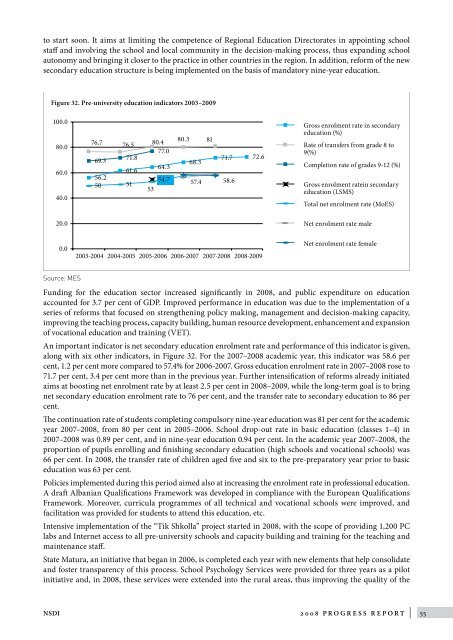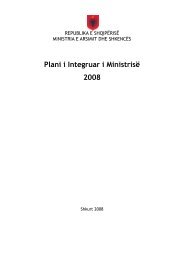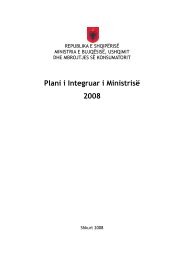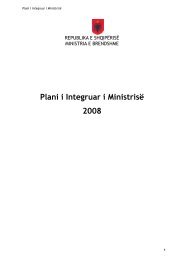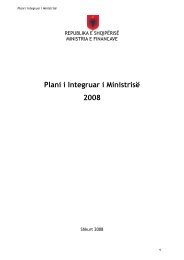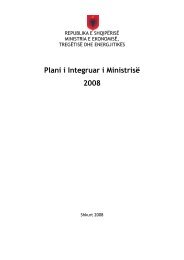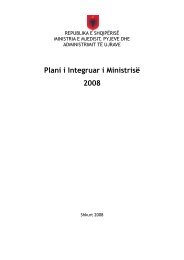Department of Strategy and Donor Coordination
Department of Strategy and Donor Coordination
Department of Strategy and Donor Coordination
Create successful ePaper yourself
Turn your PDF publications into a flip-book with our unique Google optimized e-Paper software.
to start soon. It aims at limiting the competence <strong>of</strong> Regional Education Directorates in appointing school<br />
staff <strong>and</strong> involving the school <strong>and</strong> local community in the decision-making process, thus exp<strong>and</strong>ing school<br />
autonomy <strong>and</strong> bringing it closer to the practice in other countries in the region. In addition, reform <strong>of</strong> the new<br />
secondary education structure is being implemented on the basis <strong>of</strong> m<strong>and</strong>atory nine-year education.<br />
Figure 32. Pre-university education indicators 2003–2009<br />
100.0<br />
80.0<br />
60.0<br />
40.0<br />
76.7 76.5 80.4<br />
77.0<br />
69.3<br />
71.8<br />
64.3<br />
61.6<br />
56.2<br />
54.7<br />
50 51<br />
53<br />
80.3 81<br />
68.3<br />
71.7 72.6<br />
57.4 58.6<br />
Gross enrolment rate in secondary<br />
education (%)<br />
Rate <strong>of</strong> transfers from grade 8 to<br />
9(%)<br />
Completion rate <strong>of</strong> grades 9-12 (%)<br />
Gross enrolment ratein secondary<br />
education (LSMS)<br />
Total net enrolment rate (MoES)<br />
20.0<br />
Net enrolment rate male<br />
0.0<br />
2003-2004 2004-2005 2005-2006 2006-2007 2007-2008 2008-2009<br />
Net enrolment rate female<br />
Source: MES<br />
Funding for the education sector increased significantly in 2008, <strong>and</strong> public expenditure on education<br />
accounted for 3.7 per cent <strong>of</strong> GDP. Improved performance in education was due to the implementation <strong>of</strong> a<br />
series <strong>of</strong> reforms that focused on strengthening policy making, management <strong>and</strong> decision-making capacity,<br />
improving the teaching process, capacity building, human resource development, enhancement <strong>and</strong> expansion<br />
<strong>of</strong> vocational education <strong>and</strong> training (VET).<br />
An important indicator is net secondary education enrolment rate <strong>and</strong> performance <strong>of</strong> this indicator is given,<br />
along with six other indicators, in Figure 32. For the 2007–2008 academic year, this indicator was 58.6 per<br />
cent, 1.2 per cent more compared to 57.4% for 2006-2007. Gross education enrolment rate in 2007–2008 rose to<br />
71.7 per cent, 3.4 per cent more than in the previous year. Further intensification <strong>of</strong> reforms already initiated<br />
aims at boosting net enrolment rate by at least 2.5 per cent in 2008–2009, while the long-term goal is to bring<br />
net secondary education enrolment rate to 76 per cent, <strong>and</strong> the transfer rate to secondary education to 86 per<br />
cent.<br />
The continuation rate <strong>of</strong> students completing compulsory nine-year education was 81 per cent for the academic<br />
year 2007–2008, from 80 per cent in 2005–2006. School drop-out rate in basic education (classes 1–4) in<br />
2007–2008 was 0.89 per cent, <strong>and</strong> in nine-year education 0.94 per cent. In the academic year 2007–2008, the<br />
proportion <strong>of</strong> pupils enrolling <strong>and</strong> finishing secondary education (high schools <strong>and</strong> vocational schools) was<br />
66 per cent. In 2008, the transfer rate <strong>of</strong> children aged five <strong>and</strong> six to the pre-preparatory year prior to basic<br />
education was 63 per cent.<br />
Policies implemented during this period aimed also at increasing the enrolment rate in pr<strong>of</strong>essional education.<br />
A draft Albanian Qualifications Framework was developed in compliance with the European Qualifications<br />
Framework. Moreover, curricula programmes <strong>of</strong> all technical <strong>and</strong> vocational schools were improved, <strong>and</strong><br />
facilitation was provided for students to attend this education, etc.<br />
Intensive implementation <strong>of</strong> the “Tik Shkolla” project started in 2008, with the scope <strong>of</strong> providing 1,200 PC<br />
labs <strong>and</strong> Internet access to all pre-university schools <strong>and</strong> capacity building <strong>and</strong> training for the teaching <strong>and</strong><br />
maintenance staff.<br />
State Matura, an initiative that began in 2006, is completed each year with new elements that help consolidate<br />
<strong>and</strong> foster transparency <strong>of</strong> this process. School Psychology Services were provided for three years as a pilot<br />
initiative <strong>and</strong>, in 2008, these services were extended into the rural areas, thus improving the quality <strong>of</strong> the<br />
NSDI 2008 Progress Report | 55


